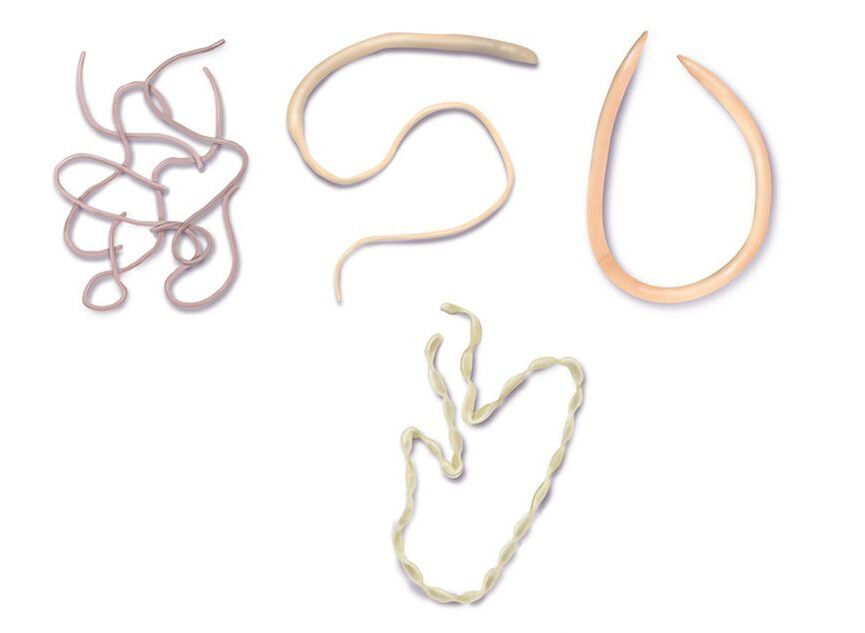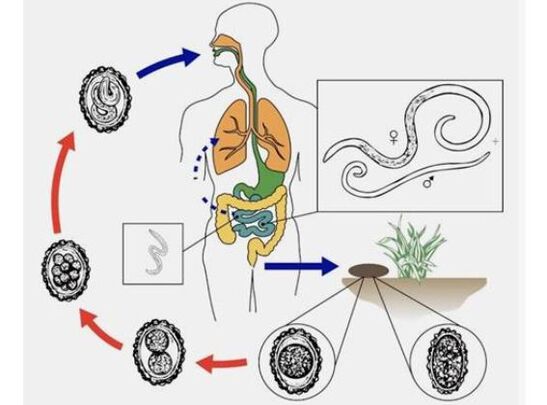parasitesis a very common phenomenon that can be easily identified in most people when they undergo a standard medical examination.
Specialists have many methods and techniques for identifying and diagnosing worms in the body of a child and an adult. At the current stage of the development of medicine, this is completely uncomplicated. In addition, many helminths can be found independently, leaving the body and entering the external environment. This process usually occurs when the female breeds and lays eggs.
Further determination of the type, quantity and duration of the life cycle of worms in humans should be carried out in special clinics during a complete examination.
Types of worms in humans

Representatives of helminths are identified on the basis of general characteristics and lifestyle, life cycle and developmental characteristics. It also takes into account how worms manifest themselves in humans, how long they live in the body and what diseases they cause.
Doctors can detect the presence of the following types of worms in the body:
- nematode, roundworm.The life cycle does not exceed 40 years, they parasitize in the intestines. It can affect the respiratory system and the stomach. Representatives: pinworms, roundworms, whipworms;
- tapeworms.They can live in the intestines and migrate through the body for about 20 years. Large sizes reach 8-10 meters. Individuals of beef and pork tapeworms, tapeworms;
- flukes, trematodes.They appear in internal organs and subcutaneous tissues. It moves into all organs and can become life-threatening.
Each of the above groups has representatives that are most often found in humans.
And each of them poses a serious danger to health and the normal functioning of the body:
- round wormIt can cause: appendicitis, jaundice, inflammation of the bile ducts;
- sedges.It leads to complications: gastritis, allergic reactions, nervous disorders;
- whipwormMay cause dysentery, rectal prolapse;
- Taxi driver.It manifests itself in reduced vision, bronchitis, necrosis of the pancreas, liver, kidneys, impaired brain function;
- echinococcus.It poses a danger in the form of anaphylactic shock, urticaria, enlargement of the liver, cyst formation and death;
- Trichinella. May cause infiltration formation, heart and brain damage;
- Giardia.Consequences: anemia, gastritis, Quincke's edema, pancreatitis;
- hookworms.May cause intestinal dysfunction;
- wide band.Promotes the development of anemia, hypovitaminosis, necrosis of intestinal tissue, damage to the spinal cord;
- filariae.It can cause diseases: conjunctivitis, lymphadenitis, asthma, abscesses; lung flukes. They provoke enteritis, bronchitis, fever, meningitis, tachycardia.
These are just some of the parasites that are mentioned quite often. There are worms that are less dangerous, but still harmful. Therefore, it is important to study them in laboratory conditions.
Worm infection

It is not difficult for parasites to penetrate the human body. They are impossible to detect or identify in the environment because they are often in the small larval stage or microscopic eggs.
There are certain methods and routes of infection:
- bodies of water In most parasites, the larvae spend the intermediate stages of their life cycle in both fresh and salt water. Sometimes they are found in intermediate hosts such as fish and shellfish;
- wet sand or soil. Together with feces, mainly eggs are released for further development or search for a temporary host;
- dirty unprocessed vegetables, berries, fruits, herbs. From the soil, the future parasites penetrate the surface of the products;
- animals: stray and domestic. Temporary carriers.
Even a simple walk with a child or a trip to the store, calling the elevator or dirty handrails can lead to the appearance of parasites. To prevent this, it is necessary to follow simple rules of personal hygiene, regularly carry out wet cleaning of the house and ventilate the room where the workplace is located.
Worms in an adult, their signs and symptoms

Characteristics alone cannot unequivocally determine whether a person has a helminth infestation.
How can you check if you really have worms?
To do this, there are general characteristic signs of the presence of worms in a person and methods for their determination:
- changes in appetite, including its increase and decrease;
- nervousness, fear, excitement. Fatigue and weakness may also occur;
- snoring, difficulty breathing during sleep;
- bowel problems, including both diarrhea and constipation;
- bloating;
- headache, dizziness;
- swelling of the limbs;
- itching in the anus;
- increased body temperature;
- fluctuations in blood pressure;
- skin rashes, redness;
- nausea, vomiting;
- tummy ache;
- brittleness of hair and nails.
These are just a few signs that can indicate the presence of worms in an adult. However, these symptoms can also be characteristic of other diseases. Therefore, only proper research will allow you to get an accurate result.
Signs of worms in children
With still insufficient immunity and protective protein cells, children are often susceptible to more serious consequences of the presence of parasites in the body:
- intestinal dysfunction, dysbiosis;
- bloating, flatulence;
- skin inflammation, urticaria;
- involuntary urination or urinary incontinence;
- respiratory diseases. Bronchitis, pneumonia, asthma;
- In girls, inflammation of the genital organs is possible;
- vomiting, nausea;
- itching and burning in the anus;
- severe abdominal pain and colic;
- sleep disorder;
- nervousness,
- Newborns can experience serious complications or developmental delays.
It is quite difficult to identify worms on your own, and many parents do not think about their presence. By trying to treat their children without the help of specialists, they can worsen the spread of parasites in the child's body. The consequences in such cases are unpredictable.
Tests for different worms

How do we know that a person develops helminthiasis?
Accurate determination of the presence of worms in adults and children is possible only with the help of specially developed research methods.
The doctor prescribes appropriate research methods depending on the symptoms and signs of parasites:
- scrapingThis is a traditional and simple method that involves taking a smear from the anus to determine the presence of worm eggs;
- stool analysis.This method has been tested, but it is not always effective, since not all helminths are found in the discharge;
- chemical general blood test.It allows you to determine only the inflammatory process through indicators of low hemoglobin levels, and also takes into account leukocytes;
- CPR diagnostics.This method consists of examining the DNA material of the parasite found in the blood compared to the available samples. Provides accurate determination of the class of helminths and their quantity;
- coupled immunosorbent assay.This method is also based on an analysis of the patient's blood. The detected samples of IgM and IgG antibodies indicate a protective reaction of the immune system to worms.
In addition, ultrasound, radiography and tomography may be prescribed. The need for them is related to the migration of parasites through the organs and their frequent change of location. The method of taking a biopsy or probing is also used to obtain material from the affected organs. The choice of diagnostic method depends on the class of the helminth and the effect on the organs.
Worms: treatment for adults and children
It is important to understand that in most cases the process of treating diseases caused by helminth infections is complicated. It is not always possible to completely get rid of the larvae and eggs of all parasites in one course of treatment. Patients often need to be under constant medical supervision and undergo regular examinations.
What to do in this case?
It is important to follow your doctor's advice and recommendations.
Broad-spectrum drugs are usually prescribed.
It is necessary to be especially careful when taking medicines for small children and newborns. The powerful components of medicinal anthelmintics are not always suitable for an organism with low immunity.
Only an experienced doctor can prescribe drugs that are appropriate for the age of the patient and the degree of complications of the disease.
FAQ
What symptoms can indicate the presence of worms in a person?
Symptoms of worms can include constant fatigue, weight loss, insomnia, itching in the anus, worms in the stool and abdominal pain.
What diagnostic methods are used to determine the presence of worms in a person?
Stool tests for worm eggs, a blood test for anti-worm antibodies, and diagnostic methods such as ultrasound and X-rays can be used to diagnose worms.
Useful tips
Tip #1
Pay attention to symptoms that may indicate the presence of worms, such as persistent fatigue, loss of appetite, abdominal pain, sleep disturbances and allergic reactions.
Tip #2
Contact your doctor for special stool or blood tests to check for worm eggs or antibodies to them.




























